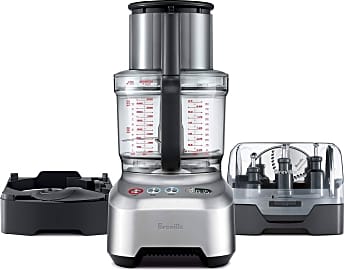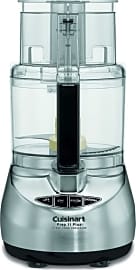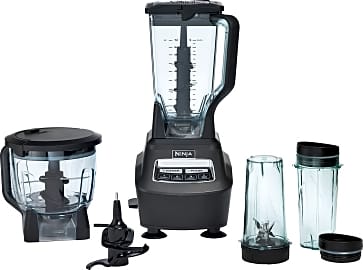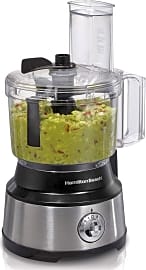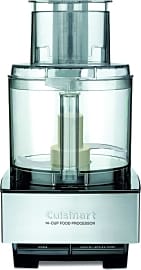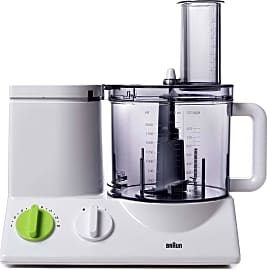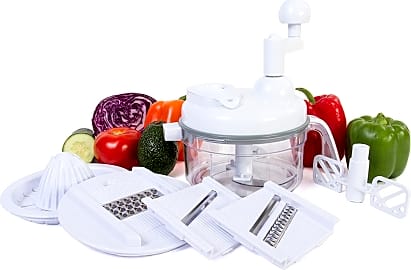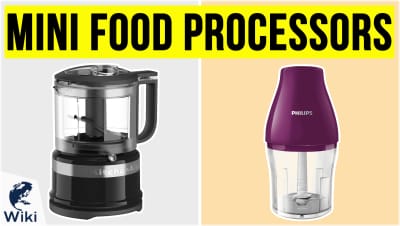The 10 Best Food Processors

This wiki has been updated 41 times since it was first published in March of 2015. If you're planning on cooking up a storm, take a look at our selection of food processors, which can reduce your prep time and help you get dinner on the table faster. We've included models ranging from light duty and inexpensive to powerhouse units that can grind coffee beans and knead dough. Whether you're making a batch of pesto or slicing potatoes for au gratin, there's an option here for you. When users buy our independently chosen editorial choices, we may earn commissions to help fund the Wiki.
Editor's Notes
December 14, 2020:
There are a few trusted brands that stand out from the pack when it comes to these food processors. The Breville Peel & Dice is a large-capacity unit with a wealth of accessories, and the company's Breville Sous Chef 12 is also a solid choice. Cuisinart offers the Cuisinart Prep 11 and Cuisinart Custom, which are well-built despite lacking some variation in speed. For budget choices, the Hamilton Beach Vegetable Chopper, KitchenAid Mini, and Ultra Chef Express have a lot to offer if you aren't planning to use this every day.
The most powerful unit on the list this time around is the Ninja Mega Kitchen System, but the overall top pick is the Ninja Foodi Power Pitcher. It's far less expensive than the Breville Peel & Dice while still offering capacity, power, and something most processors don't: control in the form of its many settings and speed adjustment knob.
December 10, 2020:
Most of the models we included in our last ranking have held steady in popularity and availability. Beloved kitchen brands like Cuisinart, whose products truly stand the test of time, and Breville, king of sophisticated functions made easy, predictably claimed the top spots once again.
One model we did pull from the list was the Ninja Precision, but the Ninja Foodi Power Pitcher kept the company on our radar, offering a convenient all-in-one approach that combines dough mixer and blender functions in addition to food processing--a huge space-saver for the gadget-happy. It boasts the most powerful motor we've seen, to boot.
May 30, 2019:
The widely-praised Cuisinart Custom doesn't come with a ton of bells and whistles, but it includes all the basics you need with none of the extras you'll probably never use anyway. It has a 14-cup bowl that's great for family dinners and batch cooking, three blades for chopping, slicing, and shredding, and simple, user-friendly controls. If you're willing to pay a bit more, the Breville Sous Chef offers a powerful 1,200-watt motor for extra tough jobs, two differently-sized feed chutes, an assortment of blades, and a solid die-cast metal base that's built to last. The Braun Ultra-Quiet is an energy-efficient model with 15 preset speeds and a variable dial, so you can set your own speed between the presets. Unlike most others, the KitchenAid ExactSlice uses a lever to change the thickness of the slices rather than a double-sided disc that only gives you two choices. It comes with some handy accessories, including a dough blade and a separate bowl for small amounts of ingredients, but the lid has a lot of crevices for food to get stuck in, so cleaning it can be a hassle.
If you don't often make elaborate meals and just want something to help you make sauces or prep small amounts of ingredients, the 3.5-cup KitchenAid Mini is a good choice. The Ninja Precision has the same capacity, with the added benefit of a spiralizer for making veggie noodles. The Koios 12-Speed has an even smaller capacity of 2 cups, but you also get an immersion blender and a whisk, and it's affordably-priced. However, note that it's not made for heavy-duty tasks and probably won't be able to handle tough fruits and vegetables.
Special Honors
Magimix CS 5200 XL Manufactured in France, Magimix's top model has simple controls but comes with a wealth of accessories. There's three bowls of different sizes, a stainless steel knife blade, dough blade, and an egg whisk, as well as multiple slicing and grating discs. magimix.com
Advantages Of A Food Processor
The demand for affordable food processors began rising as food connoisseurs and amateur chefs alike discovered the necessity of having them to recreate their favorite dishes.
In the past, food processors were reserved for top chefs and professional kitchens around the world. The demand for affordable food processors began rising as food connoisseurs and amateur chefs alike discovered the necessity of having them to recreate their favorite dishes. Now, food processors are widely available, with a broad range of pricing options and functionality.
There are many advantages to owning a food processor. Food processors can save time in the kitchen, as well as complete various tasks once thought impossible. For instance, rather than spend money on expensive baby foods which are often filled with risky preservatives and chelated nutrients; many parents turn to food processors to create affordable baby food to their liking. As a baby's first solid foods may have protective effects against allergies later in life, there is evidence to suggest that what babies eat matters more than previously thought.
The machines themselves are highly versatile, and this versatility comes in part from the use of attachment blades for the food processors. Out of the box, every food processor will contain the standard s-shape blade which does the basic cutting functions. Additional attachments can include blades for grating, slicing, ricing, and even kneading dough. A good food processor can replace graters, mandolines, coffee grinders, ricers, and bread mixers; all with a simple attachment. This makes them the perfect addition to any kitchen in which space is an issue.
Food processors also have a distinct advantage over manual labor. When grating potatoes for hash browns by hand, the process is both painful and time-consuming. With a grating attachment for the food processor, this literally becomes a push-button process. The cost of convenience alone pays for itself, no matter the price of the food processor.
Health Benefits Of Having A Food Processor
The use of a food processor keeps the creative possibilities flowing in the kitchen, partially because they are so flexible. Food processors can be used to easily puree soups, create sauces, rice potatoes, or grate carrots. The culinary uses are limited only by the cook's imagination and how many attachments they utilize. This poses some great health benefits, as each meal made at home can translate to a reduction in calories, salt intake, and fat intake when compared to restaurants of any kind.
Food processors also promote weight loss simply through the action of playing with a new toy.
Food processors also promote weight loss simply through the action of playing with a new toy. Whenever a new purchase is made, the first instinct is to try it out; figuring out the full range of abilities of the new device as quickly as possible. With a food processor, this interest is enough to keep the user away from the fast food line, saving further money and possibly shaving a few inches off of their waistline.
Fast food restaurants are calorie-traps; high in salts, sugars, saturated fats, and eyebrow-raising additives that should not be ingested. Even an identical meal made at home using a food processor will be much healthier than one purchased from a restaurant or fast food chain. The simple act of making food also burns calories. Admittedly, not many; though still many more calories than it takes to drive to a restaurant and wait for a meal. Making a meal also works up the appetite, and gets the digestive juices flowing; allowing for better digestion when the meal is eaten.
Using The Food Processor At Home
Using a food processor at home can be an easy way to healthily satisfy the urges for sweets like ice cream and frozen yogurt. Quick, easy recipes for soft serve ice cream litter the internet. Many are made in minutes using a food processor, and have ingredients as simple as frozen bananas and chocolate chips. No matter the choice of toppings, this makes for an extremely healthy alternative to store-bought ice cream.
No matter the choice of toppings, this makes for an extremely healthy alternative to store-bought ice cream.
In a pinch, a food processor can also be used to create food staples. If the house is out of butter, but has heavy whipping cream and salt; the process is as simple as adding the ingredients to the canister and processing until the cream solidifies. The process is much less involved than making true farm butter, yet the results are no less satisfying.
Food processors can also turn many of the user's favorite grains into flours quickly and easily. For example, gluten-free oat flour for those with sensitivities to wheat gluten. Typically, oats and wheat are processed in the same factories, so any processed oats like oatmeal or oat flour will automatically contain wheat. Using whole oats and a food processor, truly gluten-free oat flour can be created in a matter of minutes at a fraction of the cost of specialty sellers.
Instead of spending extra money at the local grocer for them to grind meat into burger patties, the process is extremely simple with a food processor. Add small cuts of raw meat and spices to the canister and process until the ingredients are small enough to press into patties. This same process can be used to create things like hummus, nut butters, mayonnaise, and even latkes.


